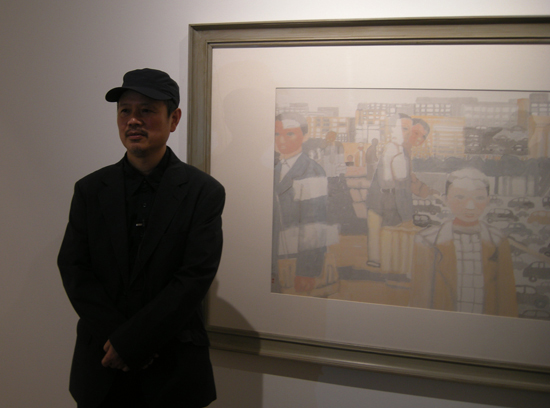티엔리밍(田黎明, 男, 1955년 5월 3일 베이징 출생)은 안후이성(安徽省) 허페이시(合肥市) 출신으로1971년 군에 입대하여 사병, 문화 간사(幹事), 전문 창작원을 담당하였다.
1982년 중앙미술학원에서 연수하였고 1984년 학교에 남아 중앙미술학원 중국화과에서 교편을 잡았다. 1989년 중앙미술학원 중국화과 루첸(卢沉)교수의 석사 연구생으로 입학하였고 1991년 문학석사학위를 받았다. 1995년부터 2002년까지 중국화과 부학과장을 역임하였고 2002년에는 중앙미술학원 중국화과 학과장직을 맡았다. 2005년부터 2008년까지 중앙미술학원 중국화학원(中國畵學院) 원장을 담당하였고 2009년에는 국가화원(國家畵院) 부원장을 담당하였으며 2010년부터 현재까지 중국예술연구원(中國藝術硏究院) 부원장을 담당하고 있다. 현재 중국미술가협회 이사, 중국화예술위원회 부주임, 중국화학회 부회장, 북경미술가협회 부주석, 중국예술연구원 박사지도교수를 담당하고 있으며 국무원 특별 수당을 받고 있다. 2008년에는 러시아 상트페테르부르크 인스티튜트(St. Petersburg Institute for Painting, Sculpture and Architecture) 명예교수로 초빙되었다.
주요작품으로는 ‘향촌’, ‘도시’, ‘햇빛 아래 수영하는 사람’, ‘티베트’, ‘고사(高士)’, ‘사람과 자연’, ‘화조’, ‘테마 창작’, ‘스케치’ 등을 주제로 하는 창작물 시리즈가 대표적이다. 그 가운데서 중국화 《비림(碑林)》은 전국 제6회 미술전시회 우수상을 받았고 《냇물》은 베이징 88국제수묵화전시회에서 대상을 받았으며 《햇빛 아래 수영하는 사람》, 《해바라기》 등은 93비평가 추천 전시회에 출품했다. 《뢰봉(雷鋒)》은 중국공산당 창립 80주년미술작품전에 출품했으며 《티베트의 햇빛》, 《진성(進城, 도시에 들어가다)》은 베이징 제2회, 제3회 국제미술비엔날레에 연달아 출품하였다. 화첩 《티엔리밍 화집》(영보재(榮寶齋)), 《티엔리밍 화집》(광서미술출판사), 《티엔리밍 전집》(영보재), 《당대 신진 문인화 대계(當代新文人畫大系)·티엔리밍 화집》(하북교육출판사)등과 문집 《햇빛에 들어가다》, 《인연과 물건은 물과 같다》를 출판한 바 있다.
개혁개방 30년 동안, 중국의 전통문화정신은 현대에 이르러 생기와 활력을 얻게 되었다. 이는 중국화의 수묵 언어가 역사의 문맥 계승 과정에서 어떻게 현대화 될 수 있는가에 대한 다양한 가르침을 주었다. 티엔리밍의 예술 체험과 미적 가치관은 이러한 배경을 바탕으로 탄생했다. 그는 ‘사람을 근본’으로 하고 자연적으로 ‘도를 취하는’ 방식으로 전통문화 관념을 현대 문화 환경에 맞게 전환시키는데 성공했다. 그는 시종일관 전통 문화의 정수를 피부로 느끼며 ‘도심을 품고’ ‘화합’한다는 심미적 이상을 유가의 인생철학과 결합하여 평범함과 천진함을 추구하는 미적 가치관을 그의 작품에서 형성하였다.
그는 사람과 자연의 조화를 창작의 법칙으로 하고 여러 해 동안의 예술 창작을 몸소 실천하는 과정에서 ‘융염법(融染法)’, ‘연체법(連體法)’, ‘위묵법(圍墨法)’의 중국화 수묵 표현 방식을 점진적으로 탐구하고 형성하였다. 이러한 방법은 전통적인 몰골법(没骨法)을 토대로 더욱 깊이 있는 발전과 완성을 이루었다. 그는 전통적인 몰골법(没骨法)을 체계적으로 확장 및 발전시켜 나가기 위해 노력했으며 이로써 전통적인 수묵의 표현력이 오늘날에도 여전히 활력이 충만한 생명력과 생기를 자랑할 수 있게 되었다. 그의 독특한 예술 언어는 ‘하늘과 사람이 하나가 되는(天人合一)’ 인문 인식을 전달하였으며 자연, 사회, 사람의 정신적 경지와 시대의 숨결을 체험하여 조화로운 인생 추구를 노래하였다. 동시에 빛에 대한 표현은 그의 필묵으로 하여금 더욱 획기적으로 색채와 빛의 감각을 갖고 동방인의 세심한 감성과 조용하고 평화로운 심미 이상을 표현하도록 하였다. 티엔리밍의 화풍은 중국화 필묵의 전통을 보존하였을 뿐만 아니라 새로운 시대의 새로운 패턴을 개척할 중국화의 방향을 표현하였다.
그의 많은 작품에는 온건함과 평안함 그리고 친절하고 너그러운 아름다움이 담겨 있으며 이 진리를 정확하게 파악하고 있다. 인생(서민)에 대한 나날이 강렬해지는 그의 책임감, 그리고 진선미(眞善美)에 대한 체험 및 감흥은 ‘햇빛, 공기, 물’의 주제로 전환되어 중국 문화의 평온한 예술적 경지가 작품 속에 가득하게 되었다. 그는 평온한 화풍을 만들어내었고 그에 맞는 기교와 기법을 모색하여 예술적 경지로 승화시켰으며 수묵화의 정신과 형식 탐구 두 가지 측면에서 뛰어난 공헌을 하였다. 티엔리밍은 과감함, 탐구적 정신, 창조성을 갖춘 ‘학자형’ 예술가이다. 그는 자각적인 문화 사고방식과 참신한 예술 창조 및 실천으로 중국 수묵 인물화의 새로운 지평을 열었으며 중국 수묵화의 시대적 변혁의 길에서 큰 한 걸음을 내디뎠을 뿐만 아니라 중국화의 시대적 전환과 시대를 아우르는 미적 가치관의 진화와 발전을 탐구하기 위해 심혈을 기울여왔다.














